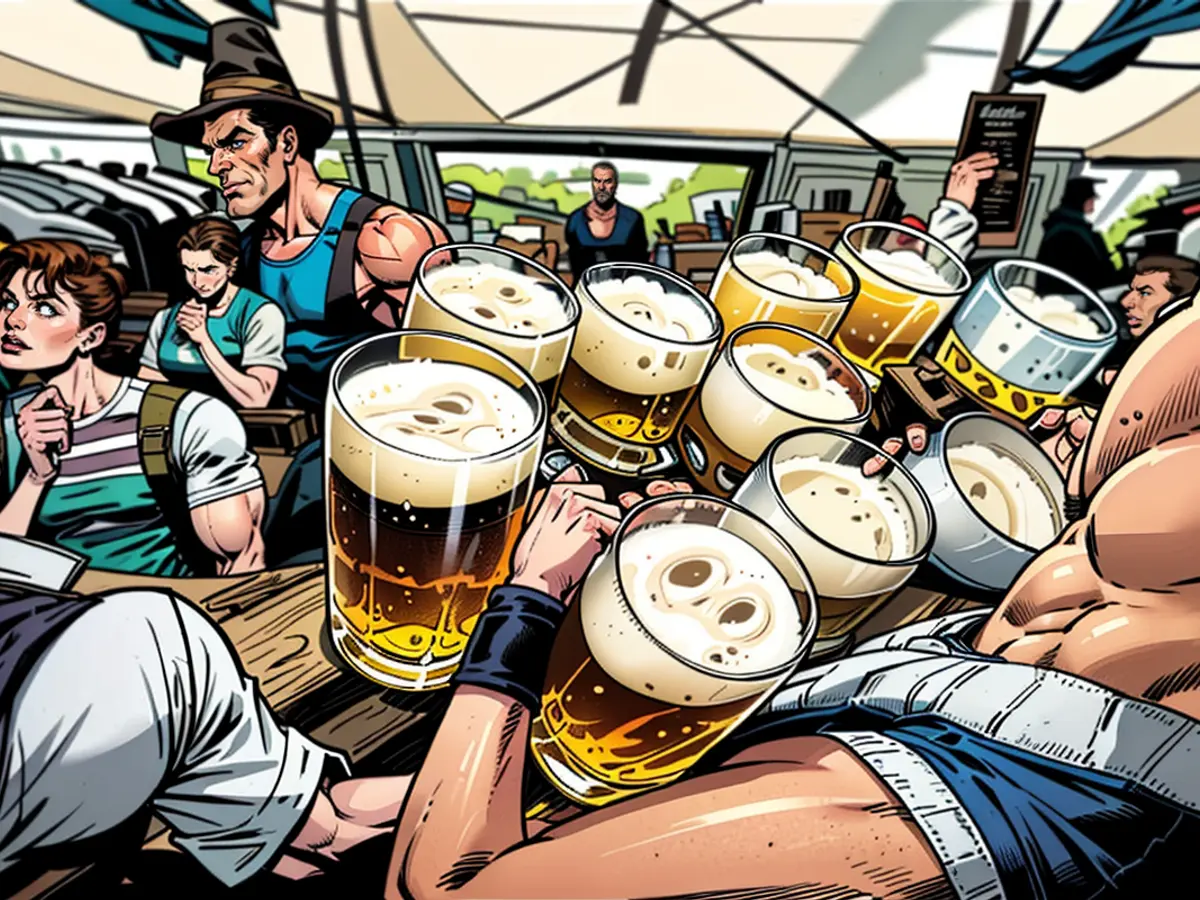Table of Contents
- Drinking beer
- Eating sausage
- Going to the pub
- Driving a car
- Going to the stadium
- Beer, sausage and fat cars <unk> what's wrong with prejudice about Germans
Germany, that's beer, bratwurst, Bundesliga, and driving a thick car – and for many, visiting the pub is also part of German culture. Statistics provide insight into how and where Germany is actually developing with these clichés. Let's just say: Some people might need to be very strong now, because there's surprisingly a lot of movement and unexpected trends in the supposedly unchangeable German habits.
Germany and its traditions:
Drinking beer
Even though poet August Heinrich Hoffmann von Fallersleben (1798-1874) in "Das Lied der Deutschen" – from which the German national anthem originates – does not mention beer, but wine ("German wine and German song, shall keep their old beautiful sound in the world"), many abroad think of beer when they hear the word "Germany". Especially of the Oktoberfest in Munich. "The art of brewing is a trademark of Germany," declares the German Brewers' Association.
But it has to cope with a significant development. In the last 25 years, per capita consumption here has decreased by about a third. Nationwide, it was recently only 88 liters, of which almost 8 liters were non-alcoholic beer. Five years ago, it was still 99 liters of beer. The development seems to be rapid. Cheers, Germany? Apparently, less and less.
Eating sausage
Grilling bratwurst in the summer, eating Bockwurst on Christmas Eve, ordering currywurst in the canteen – little seems more German than sausage. Whether Thuringian Rostbratwurst, Nuremberg Rostbratwurst, or one of the many other varieties: For many tourists, trying sausage specialties, for example in Bavarian inns, Cologne pubs, or Frankfurt apple wine taverns, is part of their visit to Germany.
But the Federal Association of German Sausage and Ham Producers has a bitter pill to swallow: Per capita consumption of meat products such as sausage or ham is decreasing. Ten years ago, it was almost 30 kilograms, now it's only about 25 per year. Overall meat consumption is almost 10 kg less per capita than in 2014. Pork is still far ahead with 27.5 kg per capita, but ten years ago, it was ten kg more. Also, fresh meat counters in supermarkets seem to be dying out.
Going to the pub
"Die kleine Kneipe in unserer Straße – da, wo das Leben noch lebenswert ist," Michael Kunze wrote for Peter Alexander almost 50 years ago. "Dort in der Kneipe in unserer Straße, da fragt dich keiner, was du hast oder bist." Well, these places are disappearing more and more. For some time now, an enormous pub closure has been recorded in Germany.
According to the DEHOGA federal association (Hotel and Restaurant Association), citing the Federal Statistical Office, there were still about 31,000 pubs in 2015. In 2019, there were still almost 29,000, but in 2022, there were only 21,000 left. Figures for 2023 will be published by the Federal Statistical Office in March 2025.
In between, there was – we remember – the Corona pandemic with its devastating effects on the catering industry and going out behavior. Rising costs for energy, rent, and personnel probably do the rest.
Germany is the "Auto" Nation. "The automobile was invented in Germany. The passenger car, the truck, and the bus," declares the Association of the Automotive Industry (VDA). "The electric motor was also invented in Germany, as was the computer." The goal, according to VDA, is "climate-neutral mobility by 2050. With electric drive, with e-fuels, with hydrogen."
With the strong environmental movement, some people might think that Germany is turning away from the car and individual traffic. However, this assumption is incorrect. Statistics from the Federal Motor Transport Authority in Flensburg show: Ten years ago, there were about 44 million registered passenger cars in Germany, today there are more than 49 million.
The highest increase in the number of registered passenger cars was recently seen in the segment of tank-like SUVs, of which there are now around six million - about twice as many as five years ago. Big cars in Germany? You bet!
Going to the Stadium
The Bundesliga is one of the top leagues in football. However, there is a downward trend in attendance. While 13.3 million spectators were counted at the games of the (first) Bundesliga in the 2018/19 season, there were only 11.9 million in the 2023/24 season. In terms of leisure activities, attending a stadium can no longer be considered unique.
On the other hand, theater attendance looks different: Due to the federal structure of Germany, it has developed into the richest theater landscape in the world - because for centuries there were many small states and rulers with their own courts on German territory, where often also their own theaters were founded. Every year, more people visit theaters in Germany than Bundesliga stadiums.
However, there is also a downward trend here. In the pre-Corona era (2018/19 season), 22.9 million theater spectators were counted. Recently, it was 19 percent less. The latest statistics from the German Stage Association (2022/23 - the first "normal" theater season after three seasons with Corona closures) show an audience of 18.6 million spectators.
Prejudices about German culture often revolve around beer and sausages, but statistics reveal a different picture. Per capita beer consumption has decreased by about a third in the last 25 years, and non-alcoholic beer now accounts for nearly 8 liters of the annual 88-liter total. Similarly, sausage consumption has also seen a decline, with per capita meat product consumption reducing from almost 30 kilograms ten years ago to about 25 kilograms today.







